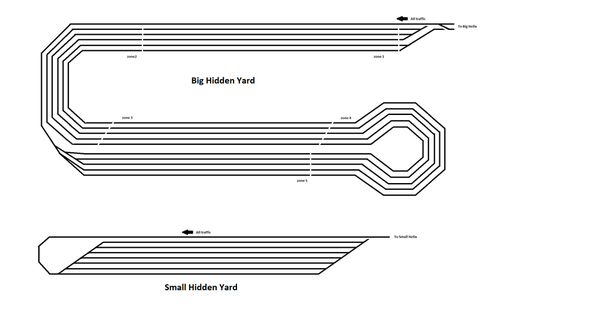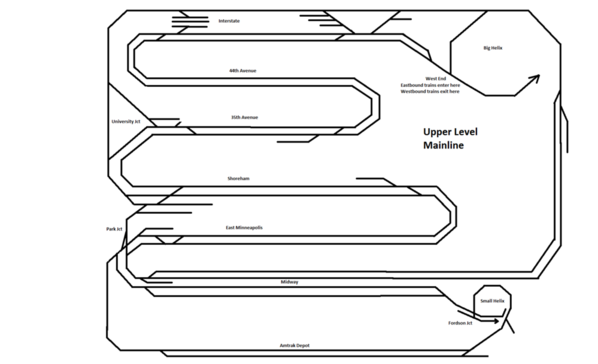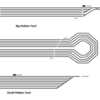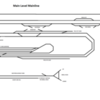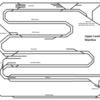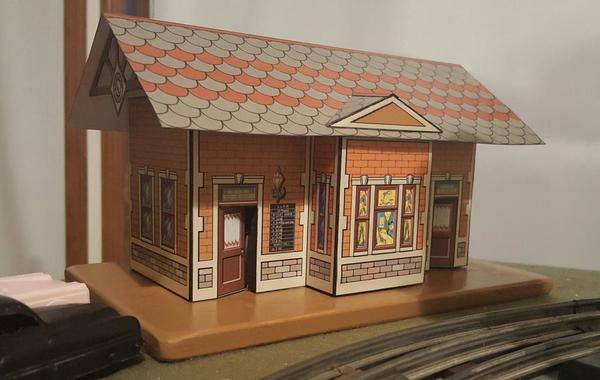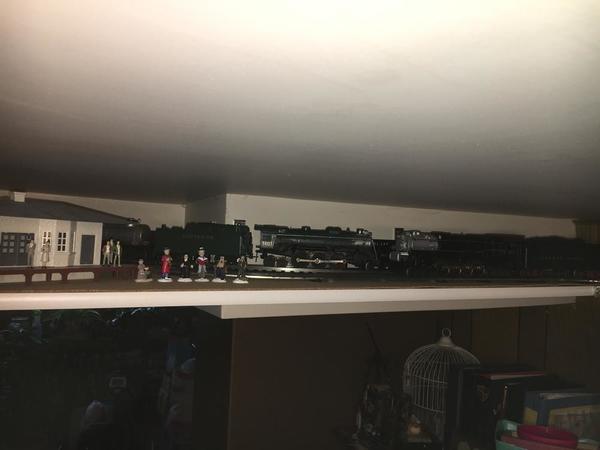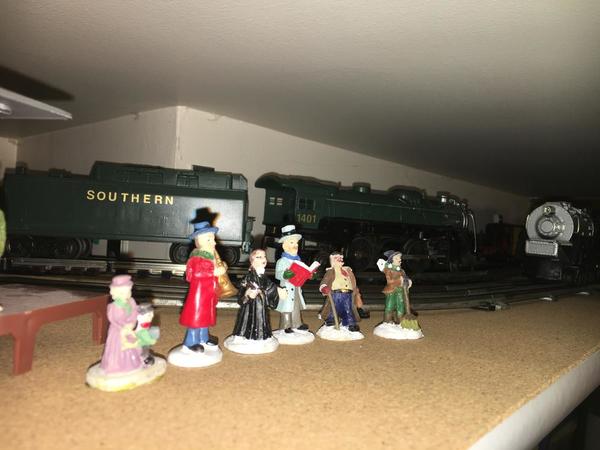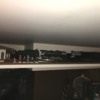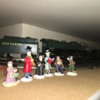JHAINER, I think it looks great. Very nice work!
Thank you.
Attachments
woof! fabulous.
Well, I finally did it. I now have a complete and accurate, schematic drawing of all 3 levels of the layout. These are just the mainline, no yard or industrial tracks. Those locations are indicated by stub tracks connecting to the mainlines. Click on them to enlarge.
Attachments
Big_Boy_4005 posted:
That's quite an accomplishment, both in terms of the drawing and construction. Congratulations! Out of curiousity, did you use Visio or something else?
Thanks Len. Actually, I went very low tech. Those were done with MS Paint. A little time consuming and tedious, but the results aren't too bad. All of the track shown in the diagrams has been completed on the layout.
I needed to do these so I can finish my signal planning, and prepare for JMRI Panel Pro, among other things. These will give me a rough idea of what has to be drawn for my control panel. BTW, I consider the hidden yards to be part of the mainline system. I've included every Tortoise powered switch, as that is my definition of mainline.
I'm not sure if I'm happy with everything yet. The upper deck plan is very true to the way it looks in real life. The main level, I tried to condense out an aisle by making the plan wider, so it would look more like a real dispatcher's panel. The whole thing gets a little confusing because of all the serpentine folds going around all the peninsulas. Work in progress.
brwebster posted:Future SPCA inspector thinking," Doz poor Jeerafs bin cooped up in doz cars too long. Let dem out for a stretch! "
![]()
![]()
![]()
Mitch
M. Mitchell Marmel posted:brwebster posted:Future SPCA inspector thinking," Doz poor Jeerafs bin cooped up in doz cars too long. Let dem out for a stretch! "
Mitch
But dey gotz no legzez.![]()
Big_Boy_4005 posted:But dey gotz no legzez.
Yes dey duz! Dey stickin' outta bottom! ![]()
Mitch
I very crudely roughed in an elevation change on the outer track around the yard, on the lower level.
I raised it 4" because it's along the back, so now you can see a train on it, with a lot of stuff in the yard.
I also had to delete and re-add my new switcher. It kept telling me it wasn't on the track ![]()
Really nice job on the station !!
I love your buildings,Andy! You're a man after my own heart. I love building in cardstock,too.
Mike
I worked on my Ceiling Central RR today. Replaced one section of original shelving that was too narrow for the second track, and finished laying track on the second loop. I removed all the rolling stock from the track that wasn't finished before today, and connected both loops to transformers. I did some preliminary running on both loops checking clearances. All looks good for putting it into operation. I'll take a video later, as it was late when I cleaned up.
Cut a bunch more foam for the back corner terrain forms.
I took some dirt from the actual area I model over to Home Depot and had them mix up a gallon of latex paint to match it. I'm going to paint over all the terrain and then I can start with grass and bushes...
Whàt else, ran Trains of course!!!!
Over the last few days I have spent a few hours running trains and preparing for an upgrade to my layout.
I have finalized the dates with my layout builder, I feel good about that. I ordered 2 new ZW-L's, and am contemplating getting the MTH WiFi devices for my layout. I would need three of them. I saw the YouTube of it and it looks really cool
I also ordered the new DCS digital book today. I am going to replace one of the old TIU's, and already have it sitting ready for installation.
I'm pretty excited about this, although we are soon to be leaving train and being in the basement season, oh well.
Matt,
I recouped some of my Child Hood Tin Plate Marx Village this past week, both original items were in perfect shape and from the 50's era. I wanted the originals to be in pristine shape, I quickly found that this was not an easy task.
PCRR/Dave
Attachments
I spent a good portion of the morning trying to diagnose a running problem with my big 1835 Lionel Standard gauge steam loco. Runs smooth as silk in reverse but would just sit and chatter in forward. The engine was like locked up but would get going if I pushed. Took the motor(Bild A Motor) out and cleaned everything I could reach but no real luck. then I noticed an empty screw hole in the brush plate and part of the motor was a little loose and rotate just a little. That seemed to be the problem. Found a screw to fit, tightened it the wedged a small piece of wood to tightened it better. Ran good but then after the shell went on-not as good but better than before. I think I know the problem but not sure of the fix. I set it aside for another day before I fool with it again. Put some vintage tin on track and ran it as therapy. Looked at my G gauge outside and looks like it came through the winter in pretty good shape.
Worked on a few projects this afternoon. First, I found a different caboose to use as the base for my TMCC signal test car. I just have to do the disassembly of the old one and put it back together on the new chassis. Second, I put up the last couple sections of edging on the big hidden yard. Still want to do the small hidden yard.
Finally, I started the rebuild of the big helix. When I built it, back in 2003, nobody was making any cars over about 18", and no large articulated locomotives. The longest cars I had were a Williams Luxury Liner set of Amtrak Superliners. Now 21" cars aren't uncommon. The support columns were close, but the Williams cars cleared. Now the ladders on the Lionel auto racks just hit. Time to fix this once and for all.
Joe and I ripped a sheet of 3/4" plywood into what amounts to 1x4's. So far, the old supports have been coming out easier than I expected. The hardest part has been detaching all the feeder wires from the supports on the inside.
So far, I've started with the easy ones. Some of these are going to be hard to get at.
Attachments
I am still working, slowly, on my caboose/coach for my pickle branch train. Tonight I put together the handrails for the platforms and glued them in place, stealing the handrails out of a Bob Peare "TrainCraft" bobber kit. (if I build the TC kit later, I will form new handrails to match the pattern in the kit instructions)
Currently laying new track with power drop wires to an extension on my layout. Also at the same time, drilling holes for wiring of the switch tracks.
Ran trains, Finished Kadee conversions of my Lionel Reefers. Made a video
Very little, but it made a big impact to the (classroom, O-scale) layout.
On Sunday I found some lovely flowering trees in the dollhouse dept. at my local train shop. They had just come in, and weren't even out on the floor yet. From Model Builders Supply, MBS in Canada. Used four- 3" flowering trees on the right side of the town church, all [planted] in a row. Used four- 2" (flowering) crabapple trees on the edge of the church and at the cottage. As there is nowhere else on the layout with flowering trees, this area makes a nice little showcase area for them. Easy to add these, they have a stick end that you can just poke a hole into the styrofoam bases.
Attachments
Thanks for sharing. Those trees are really nice! I just checked their website and there is a wealth of usable stuff available .Thanks again!
Mike
The Golden Spike Ceremony for the Ceiling Central Railroad was held on March 6th, 2016 at South Mountain, Butler, Pennsylvania! Several dignitaries were in attendance. Reverend Martin Luther gave the invocation and closing prayer at the affair. Mayor David Lawrence donned his robin egg blue top hat and coat to read a lengthy speech he had been working on for 3 years just for this event. Chief Engineer Edgar Thompson stood by proudly so much so that it seemed his buttons would bust. Chief Musician Stephen Foster played a note to which both engines blew their whistles. One of the laborers was selected to represent the man who put in many hours of physical toil to make this day a reality. Mrs. Lawrence and Sonny rounded out the group of dignitaries. Many folks looked on, some from the station steps for a better view.
The engines of honor were both reworked and custom painted by my friend Daniel Burgess. On the right was a 671 with a little extra trim painted. On the left, the newest acquisition was the 2026 painted in Southern green. Both trains made a few trips around the loops. As with any project, there are many cosmetic improvements to finish afterwards, but the trains need to start hauling freight and passengers to bring in some revenue.
Attachments
Great work Mark, They look like they will be a blast to run! Just one question. Ain't you worried about them jumping track going warp speed?
Again looks wonderful!
Thank you Mike! You are right, and I normally don't run trains that fast, by any means. I was testing to see what they would do. You may notice, I need some angled shelving in the corners under the curves too.
Mark
It great that the ceremony has taken place. I noticed that you needed to add some corner pieces. Look forward to see the continued improvements. I hope the engineer knows he needs to slow down. ![]()
Yes engineer Casey Jones has been reprimanded more than once! He obviously was showing off for the crowd this day. It was decided it would be bad PR to reprimand him on the big day, so he was given a warning! Management is considering reassigning him to the K-Line 0-4-0 switcher to see if he behaves. Thanks for the concern!!
On the subject of gi-raffe legs: Had a 3376 develop a wobbly actuator at the train show back on 2/27, so I straightened out the pivots this weekend...
At the left, the trolley sweeper is progressing slowly but surely. The Pittman single truck work motor body is now attached to the Lionel chassis with brass 2-56 screws, and the next step is to fabricate brackets for the sweeper brooms... ![]()
Also did my semi-annual "sweep the debris offa the workbench" bit. Don't worry, it won't stay clean long... ![]()
Mitch
Attachments
Congratulations Mark. ![]() I bet it feels wonderful to finally reach this point in the project. I hope you have many years of enjoyment.
I bet it feels wonderful to finally reach this point in the project. I hope you have many years of enjoyment. ![]()
Yes Pat, it does feel good to get trains rolling! While I was suffering from my reocurance of carpal tunnel syndrome, I sometimes looked at the incomplete shelves as the infamous Bridge to Nowhere that stood many years in Pittsburgh before they completed the ramps that come off between the two stadiums. lol. I am the first to admit, it isn't the best looking ceiling layout, but my wife isn't complaining, so I am happy with my results! The project was her idea in the first place! She is the best!
Mark,
Congratulations on completing the "Ceiling Central Railroad". Enjoyed the video, thanks for sharing.
Dave
Mark Boyce posted:... the infamous Bridge to Nowhere that stood many years in Pittsburgh before they completed the ramps that come off between the two stadiums.
If you'll allow me to be a butinski, here, Mark and Pat, I took a ride on a Honda50 motor-skooter, one night, many decades ago, when I was very young, onto the ramp that later became the entrance roadway to the Fort Pitt Tunnel, stopped at the very edge, and looked down at the very dark river waters, just for a "rush." Oh, it was a rush, all right. And I got out of there pronto, esp. since there was very little preventing a vehicle or a person from going over the edge. Ahhhh youth, when life was a total adventure and we were invulnerable.
Maybe I'll go down into the basement and climb around on the layout a little bit, now.
I'm glad you are so content w/ bringing your project to fruition and that your hands are better, apparently, allowing you to work a bit better at it.
FrankM.
Moonson posted:Mark Boyce posted:... the infamous Bridge to Nowhere that stood many years in Pittsburgh before they completed the ramps that come off between the two stadiums.
If you'll allow me to be a butinski, here, Mark and Pat, I took a ride on a Honda50 motor-skooter, one night, many decades ago, when I was very young, onto the ramp that later became the entrance roadway to the Fort Pitt Tunnel, stopped at the very edge, and looked down at the very dark river waters, just for a "rush." Oh, it was a rush, all right. And I got out of there pronto, esp. since there was very little preventing a vehicle or a person from going over the edge. Ahhhh youth, when life was a total adventure and we were invulnerable.
Maybe I'll go down into the basement and climb around on the layout a little bit, now.
I'm glad you are so content w/ bringing your project to fruition and that your hands are better, apparently, allowing you to work a bit better at it.
FrankM.
Frank,
You didn't happen to know the 21-year old Chemistry student in this excerpt below did you? I remember when it happened.
The Fort Duquesne Bridge is a steel tied arch bridge that spans the Allegheny River in Pittsburgh, Pennsylvania. It was colloquially referred to as "The Bridge to Nowhere". It was constructed from 1958-1963 by PennDOT, and opened for traffic October 17, 1969 with its predecessor Manchester Bridge (located closer to the tip of Point State Park) closing that same day (it was demolished in the autumn of 1970). The bridge was given the name "The Bridge to Nowhere" because the main span was finished in 1963, but due to delays in acquiring right of ways for the northern approach ramps, it did not connect on the north side of the Allegheny River. The total cost was budgeted at $5 million in 1962.[1] The lack of approach ramps meant the bridge ended in midair, rendering it useless. The northwestern ramps were completed in 1969, allowing access to Pennsylvania Route 65. The northeastern ramps were completed in 1986, with the construction of the northern section of Interstate 279 (North Shore Expressway) which runs through Downtown Pittsburgh'sGolden Triangle and north towards Interstate 79. The bridge touches down halfway between Heinz Field and PNC Park Baseball Stadium on the City's North Shore.
On December 12, 1964, Frederick Williams, a 21-year-old chemistry major at the University of Pittsburgh, drove a 1959 Chrysler station wagonoff the end of the bridge and landed unhurt on the other side. His adventure is documented in WQED-TV's Mid-Atlantic region Emmy Award-winning documentary "Flying off the Bridge to Nowhere and Other Tales of Pittsburgh Bridges", narrated by Rick Sebak.




